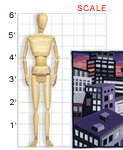From the collection of:
Museum of the American Quilter’s Society || VAM Home
Lucretia Romey (Massachusetts, b. 1934)
CITYSCAPE, 1984
Cottons, cotton blends, and metallic fabrics; hand-pieced and hand-quilted; 50" X 64"
Museum of the American Quilter’s Society, 1997.06.10
This quilt was inspired by the Toronto skyline. Its creator travels extensively and saw this view from the seventh floor of the Westbury Hotel.
About the Artist
Lucretia Romey spends several months at sea each year, teaching, painting, and drawing. She accompanies her husband, a retired college professor who lectures on oceanography. Romey says she has always liked the geometry of groups of buildings.
A painter first, Romey began quilting in the 1970s, while living in Boulder, Colorado, when she decided to quilt a landscape rather than painting it. Since then, her studio has been half for painting and half for quilting. Some of her quilts include small painted areas, and some of her paintings feature quilts. Romey’s mom sewed and her grandmother, who died before Romey was born, sewed and quilted.
Classroom Ideas
Discussion: What geometric shapes are displayed in this quilt? How is this cityscape similar to a landscape or seascape? How does the artist use repetition to create a cityscape? Why are the windows different colors? What time of day is it? How does where a person lives affect his or her life in terms of housing, jobs, shopping, recreation, and cultural activities?
Activities: Read the Langston Hughes poem “The City” and identify poetic elements such as personification, imagery, metaphor, rhyme, stress pattern, and sensory appeal. Write music for the poem or create a drawing inspired by it.
Read the story The City Mouse and the Country Mouse (available online at http://216.36.206.143/Country_Mouse/storybook/storybook.htm). Compare and contrast city and country life as seen in the story. Examine the concept of stereotypes. Establish a cultural exchange with a class that lives in a different landscape. Conduct research and plan a trip to that location. Create an itinerary for the imaginary trip, including the travel route, historic sites to visit along the way, places to stay, and places to eat.
Links
Read about a student project inspired by this work and see examples of the students’ works at the Museum of the American Quilter’s Society web site.
[www.quiltmuseum.org/detail.html?id_number=359]

